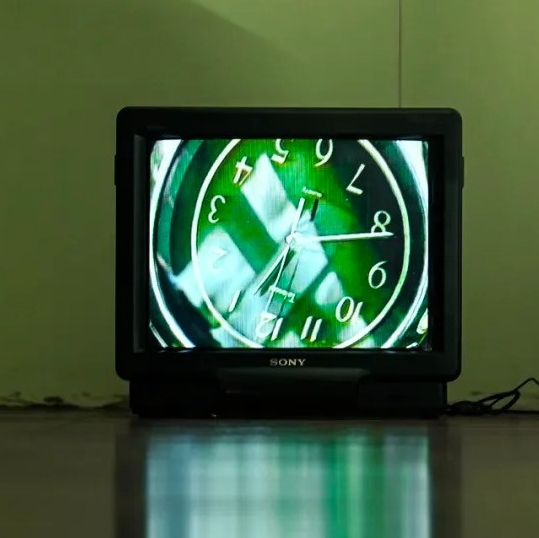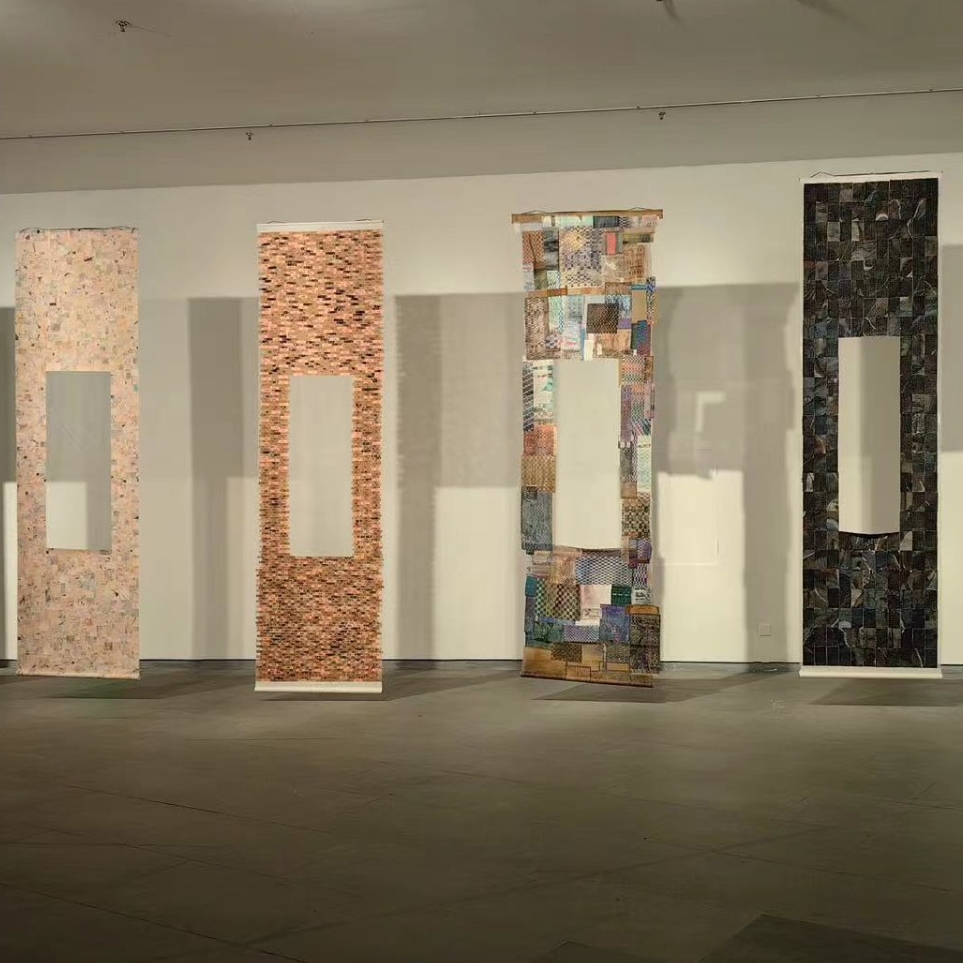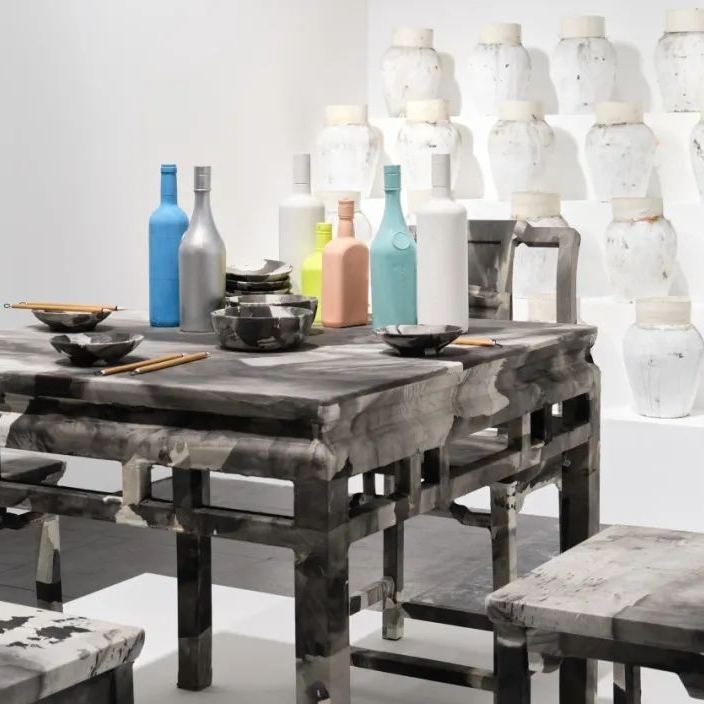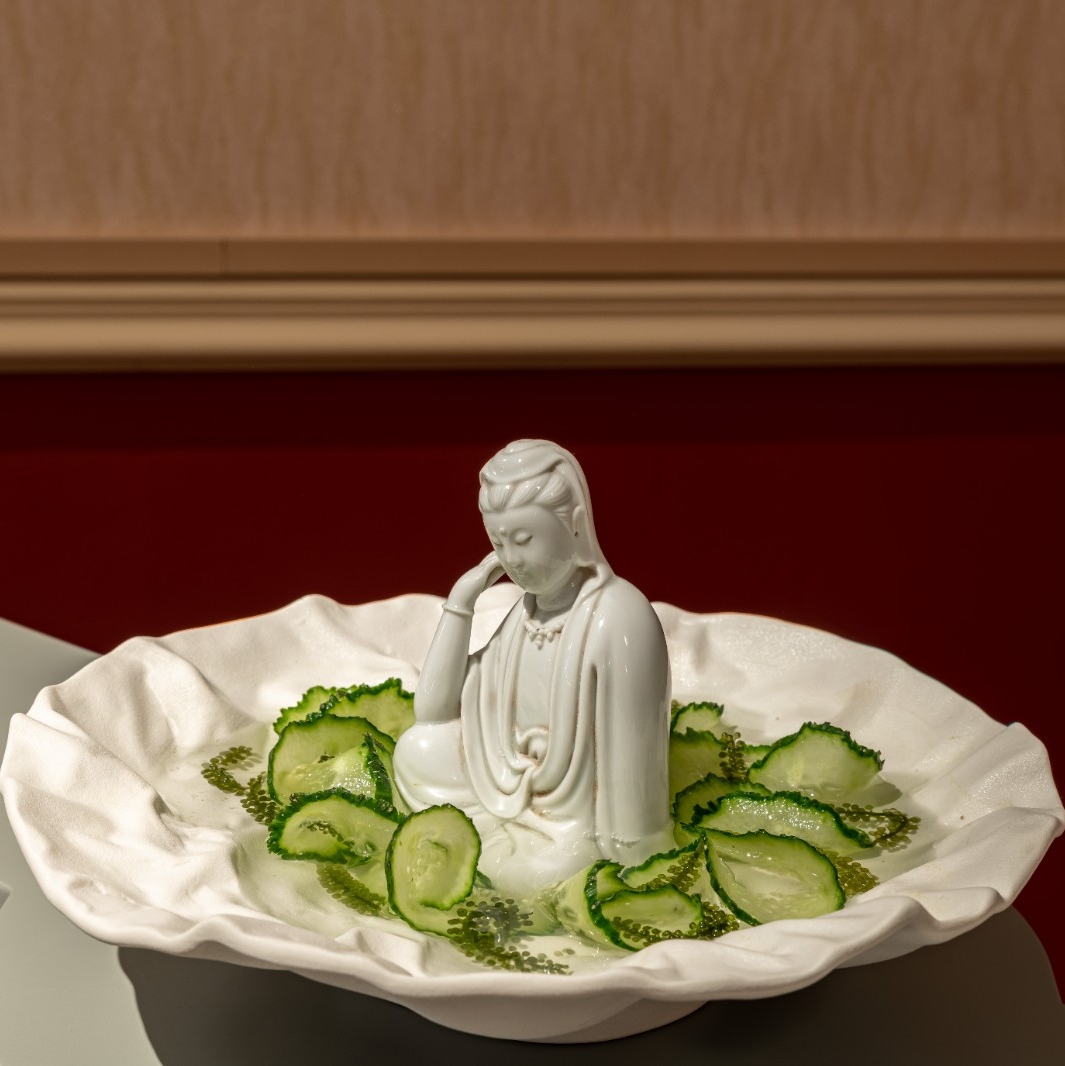On 28th October, the first Beijing Art & Technology Biennale (abbr. BATB) kicked off at 798 CUBE. Taking “Synthetic Ecology” as the title, the Biennale features three exhibition chapters of “Radical Nature”, “Entangled Life” and “Interwoven Evolution”, presenting the tension between nature and technology, discussing the condition of post-human era, and forecasting the possibility of the evolution of life in the future. By doing so, the exhibition intends to escape from the scope of anthropocentrism so as to respond to the increasingly obvious crisis in this era, such as resource exhaustion, global warming, climate crisis, the limits to growth, etc. Therefore, “Synthetic Ecology” is searching for a new consensus and possibility in the era of accelerationism with continuous development of technology and expansion of self-awareness.
Beijing Art and Technology Biennale “Synthetic Ecology”, exhibition view, photo by Donghan Wang
 Beijing Art and Technology Biennale “Synthetic Ecology”, exhibition view, photo by Donghan Wang
Beijing Art and Technology Biennale “Synthetic Ecology”, exhibition view, photo by Donghan Wang
 Beijing Art and Technology Biennale “Synthetic Ecology”, exhibition view, photo by Jinlong Liu
Beijing Art and Technology Biennale “Synthetic Ecology”, exhibition view, photo by Jinlong Liu
 Beijing Art and Technology Biennale “Synthetic Ecology”, exhibition view, photo by Donghan Wang
Beijing Art and Technology Biennale “Synthetic Ecology”, exhibition view, photo by Donghan Wang
The first BATA is co-organized by the 798 Art District and the Central Academy of Fine Arts, with Song Xiewei, the Dean of the School of Design at CAFA, as the Chief Director. Hera Lee, the Executive Director of 798 CUBE, serves as the Exhibition Director, and Professor Chen Xiaowen and Wang Naiyi serve as the co-curators. As the Chief Director Song Xiewei has mentioned, BATA gathers global participants in art, technology, ecology, and key decision fields, discussing profound issues regarding humans, technology, and future through emerging media such as digital technology. While examining the urgent issues of the moment together, the participants in BATA explore how art plus technology can effectively participate in and promote ecological restoration and climate governance in various ways. [1]
In the 1970s, English scientist James Lovelock proposed the Gaia hypothesis, which postulates that the Earth functions as a self-regulating system. The hypothesis believes that the Earth is not just a place where people live but a “living” system with a complete dynamic balance, which provides a theoretical vision beyond the dualistic thinking structure for solving the current crisis of sharp contradictions.
 Beijing Art and Technology Biennale “Synthetic Ecology”, exhibition view, photo by Donghan Wang
Beijing Art and Technology Biennale “Synthetic Ecology”, exhibition view, photo by Donghan Wang
 Beijing Art and Technology Biennale “Synthetic Ecology”, exhibition view, photo by Donghan Wang
Beijing Art and Technology Biennale “Synthetic Ecology”, exhibition view, photo by Donghan Wang
I. In Between “Gaia” and Mankind
This year, the Biennale has invited 50 well-known artists, scientists and ecologists, including Suzanne Anker, Susan Schuppli, Patricia Piccinini, Liang Shaoji, Xiang Jin, Rimini Protokoll, among others. Meanwhile, the project Climate Clock, which aroused heated discussions in the 2021 United Nations Climate Change Conference (COP26) in Glasgow, Scotland, United Kingdom, was introduced to China for the first time. These important creators in the intersection of art and technology respond and reflect on the practical situation confronted by human beings in different ways, making the overall exhibition in a fusion state featuring multi-media and interdisciplinarity.
Intriguingly, the Biennale echoes to the exhibition space as well. As a renovation project based in the 798 Art District, 798 CUBE was designed by Zhu Pei. The Bauhaus style of architectures featured by 798 Art District were taken as the initial inspiration of the overall design concept. By retaining the original old industrial plants as many as possible, the design team applied innovative architectural concept on the old basis, attracting the audience to experience the aesthetic texture of “sewing” the art museum and its history, and to explore how could the art museum interact and complement with surrounding industrial buildings.

Main Entrance of 798 CUBE ©Zhu Runzi
“Radical Nature”, the first chapter of “Synthetic Ecology”, showcases artworks applying biotechnology and artificial intelligence as media, which brings natural ecology, the development of technology, and the tension between “Gaia” and the desires of humans into conversation.
Based on research data from AI lab DeepMind, Alexandra Daisy Ginsberg’s The Substitute constructs a cyber vivosphere with video and audio installation, where the audience can witness the process of the digital “regenesis” of a northern white rhino. In 2018, the death of the last male northern white rhinoceros was reported. With only two females left so far, the species is almost declared extinct. In a lab-like enclosure space, this pixel rhinoceros gradually learns, grows, and acquires intelligence under the guidance of artificial intelligence. Along with this breeding process, the form and sound of the northern white rhino are gradually toggled from pixelation to lifelike. The virtual breeding process conducted by Ginsberg presents a sarcastic attitude—whether a lifelike virtual rhino can be a substitute for reality. Have human beings, who are constantly pursuing new technological means and the power of the Creator, lost respect for real life? Will it eventually lead to the tragedy of Icarus due to their arrogance?
 The Substitute, Alexandra Daisy Ginsberg, 2019. Image © Alexandra Daisy Ginsberg
The Substitute, Alexandra Daisy Ginsberg, 2019. Image © Alexandra Daisy Ginsberg
 The Substitute, Alexandra Daisy Ginsberg, 2019. Image © Alexandra Daisy Ginsberg
The Substitute, Alexandra Daisy Ginsberg, 2019. Image © Alexandra Daisy Ginsberg
 The Substitute, Alexandra Daisy Ginsberg, 2019. Image © Alexandra Daisy Ginsberg
The Substitute, Alexandra Daisy Ginsberg, 2019. Image © Alexandra Daisy Ginsberg

Following the same logic of bringing extinct species back to life, The Wilding of Mars, the other work created by Ginsberg images to simulate the process of plant systems forming a “garden” suitable for life on Mars by applying the power of technology. Intriguingly, the imagination that reveals the obvious ambition of invading Mars realize to avoid a certain potential colonial angle because of taking an anti-anthropocentrism perspective. It intends to empower the existence other than human beings.
 The Wilding of Mars, Alexandra Daisy Ginsberg, 2019. Image © Alexandra Daisy Ginsberg
The Wilding of Mars, Alexandra Daisy Ginsberg, 2019. Image © Alexandra Daisy Ginsberg
 The Wilding of Mars, Alexandra Daisy Ginsberg, 2019. Image © Alexandra Daisy Ginsberg
The Wilding of Mars, Alexandra Daisy Ginsberg, 2019. Image © Alexandra Daisy Ginsberg
Suzanne Anker’s Vanitas (in a Petri Dish), references the theme of “Vanitas” created by Dutch Golden Age painting in the seventeenth century. The artist replaces the intermedia of metaphorical death from wilted flowers, bones, and decaying matter in the seventeenth century to fruit slices, sea urchin exoskeletons, curly and dried orange peels, flower buds, and prickly seed pods, among other specimens, arranging them carefully in a “picture frame” of a circular petri dish. The micro-aesthetics empowered by technology reveal life and death in natural and synthetic natural life forms.

 Vanitas (in a Petri Dish), Suzanne Anker, 2016. Image courtesy of the artist
Vanitas (in a Petri Dish), Suzanne Anker, 2016. Image courtesy of the artist
 Vanitas (in a Petri Dish), Suzanne Anker, 2016. Image courtesy of the artist
Vanitas (in a Petri Dish), Suzanne Anker, 2016. Image courtesy of the artist
Neri Oxman designs “supernatural” ecologies by applying biotechnology, materials science, and digital fabrication. The artist’s design practice starts from material ecology, regarding architectural design, nature and organic organisms as a holistic design, thus changing our vision of natural ecology, and even further “designing nature”. The work Totems injects the “melanin” into the totem column and introduces a light-sensitive enzyme. By doing so, the melanin totem inside the column can change colors with the light change to realize a “chemical totem”. Herein, natural “growth” and artificial “manufacturing” intertwine and interpenetrate.
Totems, Neri Oxman and The Mediated Matter Group, 2019. Render by Eric de Broche des Combes, Luxigon. Image courtesy of Neri Oxman and The Mediated Matter Group.

 Totems, Neri Oxman and The Mediated Matter Group, 2019. Image courtesy of Neri Oxman and The Mediated Matter Group
Totems, Neri Oxman and The Mediated Matter Group, 2019. Image courtesy of Neri Oxman and The Mediated Matter Group
II. The Posthuman Condition
Giovanni Aloi, the Academic Advisor of BATA, has addressed that, “Synthetic Ecology” is an exhibition that has already happened but directs to the future. In terms of its historical features, it is significant to be aware that the post-human philosophy and aesthetics in the past 40 years have constituted the general context of this era and this exhibition. Currently, the development of technology helps humans to re-negotiate and redefine the symbiotic relationship between human beings and the ecosystem with diversified methods. In terms of the future-oriented character of this exhibition, “Synthetic Ecology” is more than a bold imagination of the future system on the Earth by artists, scientists, and ecologists, but showcases an ambition of correcting the reality—“we can develop a fundamental premise of a new awareness—the basic process of stepping towards a fairer and sustainable future.”[2]
Rosi Braidotti has described the posthuman condition in the current world as a successive unity of nature and culture. By taking the philosophy and aesthetics of posthumanism as the basic context, the BATA introduces many artworks which attempt to present and imagine the position and destiny of human beings in the posthuman situation. Besides, how to regard and solve such a condition at present is a crucial part of the participating artworks. For example, the heterogeneous and corporeal sculptures of Patricia Piccinini stand on the ambiguous boundaries between human and non-human, nature and non-nature, reminding us of the inherent entanglement, chaos, and restlessness of our life.
Beijing Art and Technology Biennale “Synthetic Ecology”, exhibition view, photo by Jinlong Liu
 Bootflower, Patricia Piccinini, 2015. photo by David Stjernholm
Bootflower, Patricia Piccinini, 2015. photo by David Stjernholm
 Kindred, Patricia Piccinini, 2018. Image courtesy of the artist
Kindred, Patricia Piccinini, 2018. Image courtesy of the artist
The video installation Community by Terike Haapoja records and stares at the process that animals’ bodies gradually cooled down after natural death through thermal cameras. This is a process of erasing the difference between the living body and the environment, which reveals the evidence of the existence of entropy, the irresistible second law of thermodynamics. The artist transforms the moment of life and death into a vision composed of red and blue. The simple technology and simple philosophy of life and death are placed in the video on the ground, lasting for a period from two to five hours.
 Community, Terike Haapoja, 2009. Image © Terike Haapoja
Community, Terike Haapoja, 2009. Image © Terike Haapoja

Community, Beijing Art and Technology Biennale “Synthetic Ecology”, exhibition view, photo by Jinlong Liu

III. Beyond the Subjectivity of Humans
Following the Gaia hypothesis, there is no break between mankind and the ecosystem, human and non-human during the entire evolution process. In addition, the Earth is a dynamic and self-adjusting overall system, which seems to be naturally connected with the Eastern philosophy of the universe and nature.
 Descending, Beijing Art and Technology Biennale “Synthetic Ecology”, exhibition view, photo by Donghan Wang
Descending, Beijing Art and Technology Biennale “Synthetic Ecology”, exhibition view, photo by Donghan Wang
 Descending, Beijing Art and Technology Biennale “Synthetic Ecology”, exhibition view, photo by Donghan Wang
Descending, Beijing Art and Technology Biennale “Synthetic Ecology”, exhibition view, photo by Donghan Wang
 Descending, Xiang Jing, 2019. Images © Xiang Jing Studio
Descending, Xiang Jing, 2019. Images © Xiang Jing Studio
In a relatively independent space, Xiang Jing’s Descending recalls the flesh body theme with the artist’s distinctive characteristics. With the assistance of technology, breath and even soul are injected into the giant octopus, blurring the boundary between animals and humans. Therefore, the work is classified as some kind of organic, contracted, and sensitive organ. The Skin by artist Liang Shaoji is composed of silk as thin as a cicada’s wing, which appears as an alienated form of a round cocoon in nature and is known as a “flat cocoon.” The artist observes the changes in the morphological structure through the experiment of the plane cocoon, perceiving the mystery of life revealed in the details. There is a part of the work that allows for touching in the exhibition so that the audience can experience the alienated cocoon’s bare skin-like texture. In Liang Shaoji’s viewpoints, “the meaning of poetry (silk) dwells in the superficial space,” which echoes Paul Valéry’s famous saying “the most profound thing is the surface skin,” on which Gilles Deleuze quoted to commenting Francis Bacon’s paintings.

 Skin, Liang Shaoji, 2019–2021. Photo: Liang Shaoji
Skin, Liang Shaoji, 2019–2021. Photo: Liang Shaoji
 Skin, Beijing Art and Technology Biennale “Synthetic Ecology”, exhibition view, photo by Donghan Wang
Skin, Beijing Art and Technology Biennale “Synthetic Ecology”, exhibition view, photo by Donghan Wang
Rimin Protokoll, a German theatre group introducing a new form of documentary theatre, transcends the subjectivity of humans in their work win > < win. As Rimin Protokoll’s most works emphasizing public participation, win > < win guides the audience to an independent exhibition hall, they can watch the story about the rise of a “jellyfish planet” which lasts for 14 minutes. The work intriguingly echoes the Climate Clock, another highlight in the BATA.
 win > < win, Rimin Protokoll, 2017. Image © Agnese Sanvito.
win > < win, Rimin Protokoll, 2017. Image © Agnese Sanvito.
 win > < win, Rimin Protokoll, 2017. Image © ArtScience Museum.
win > < win, Rimin Protokoll, 2017. Image © ArtScience Museum.
 win > < win, Rimin Protokoll, 2017. Image © David Parry+Royal
win > < win, Rimin Protokoll, 2017. Image © David Parry+Royal
The succinct figures in the Climate Clock reminds us that according to the current emission rate of greenhouse gases, there are only six years left to keep global warming below the threshold of 1.5°C. When the clock is reset to zero, global warming would apply an irreversible impact on the climate of the Earth. While the win > < win previews another future in advance, imagining the story after human beings failed to prevent the climate crisis. In this story, human beings fail to compete with the jellyfish, which could better adapt to the changed climate of the Earth. The jellyfish inherits the planet and achieves a “win-win” result with the Earth.
 Image © Climate Clock
Image © Climate Clock
 Climate Clock, Beijing Art and Technology Biennale “Synthetic Ecology”, exhibition view, photo by Jinlong Liu
Climate Clock, Beijing Art and Technology Biennale “Synthetic Ecology”, exhibition view, photo by Jinlong Liu
It can be seen that almost every piece of work presents a perspective of non-human, which acts as a clue throughout the exhibition. As curator Wang Naiyi said, the presentation of various urgent issues in the Biennale follows the clue of the passive and silent “non-human” in the traditional sense, thus questioning the dominant position of human beings in the ecosystem. The BATA presents a concern of “more than human”, inspiring us to reconsider the symbiogenesis and the interdependent relationship between humans and all things on the Earth. Only by realizing the fact that we ultimately need to coexist peacefully with animals, plants, and matters, can we human beings truly hearken to voices of all things and respect all beings.” [3]
Text by Mengxi
Translated by Emily Weimeng Zhou and edited by Sue/CAFA ART INFO.
Image courtesy of the organizer.
Notes:
[1] - [3]: Quoted from the speeches in the opening ceremony of “Synthetic Ecology: the first Beijing Art & Technology Biennale”.
About the exhibition:
 Beijing Art and Technology Biennale (BATB) “Synthetic Ecology”
Beijing Art and Technology Biennale (BATB) “Synthetic Ecology”
Duration: 2022.10.28-2023.1.31
Venue: 798 CUBE, 798 Art District, Beijing
***
Participating Artists (in alphabetical order): Alexandra Daisy Ginsberg, Anna Dumitriu & Alex May, Xiang Jing, Neri Oxman and The Mediated Matter Group, Oron Catts & Ionat Zurr, Patricia Piccinini, Ralf Baecker, Rasa Smite & Raitis Smits, Rimini Protokoll, Liang Shaoji, Sophie Falkeis, Špela Petrič, Susan Schuppli, Suzanne Anker, Terike Haapoja, terra0 (Paul Kolling, Paul Seidler, Max Hampshire), Ursula Biemann, Art of Bio Machine, Climate Clock
General Counsels: Gao Hong, Fan Di’an, Teng Yanbin
Academic Chairs: Su Xinping, Zhang Zikang
Academic Advisors (in alphabetical order): Giovanni Aloi, Yuk Hui, Jiang Yuhui, ZHANG Ga
Director: Song Xiewei
Exhibition Director: Hera Lee
Curators: Chen Xiaowen, Wang Naiyi
***
Hosts: Central Academy of Fine Arts, Beijing 798 Culture Technology Co., Ltd.
Organizers: d-School, Central Academy of Fine Arts,798CUBE, NetDragon Websoft Inc.
Co-organizer: Kulturforum der Österreichischen Botschaft Peking
Climate Action Partner: World Wide Fund for Nature
Ecological Collaborator: ORGANY





























